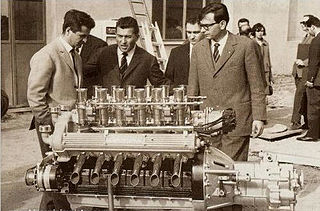
Gerhard Berger is an Austrian former Formula One racing driver. He competed in Formula One for 14 seasons, twice finishing 3rd overall in the championship, both times driving for Ferrari. He won ten Grands Prix, achieved 48 podiums, 12 poles and 21 fastest laps.

The 1988 Australian Grand Prix was a Formula One motor race held at the Adelaide Street Circuit on 13 November 1988. It was the sixteenth and final race of the 1988 Formula One World Championship, and the last race for which turbocharged engines would be eligible until the 2014 Australian Grand Prix.

The 1989 Italian Grand Prix was a Formula One motor race held at Monza on 10 September 1989. It was the twelfth race of the 1989 Formula One season.

The 1990 German Grand Prix was a Formula One motor race held at the Hockenheimring on 29 July 1990. It was the ninth race of the 1990 Formula One World Championship. The race was the 52nd German Grand Prix and the 14th to be held at the Hockenheimring. It was the 39th and last Formula One Grand Prix to be held in West Germany prior to its re-unification with East Germany. The race was held over 45 laps of the seven kilometre circuit for a race distance of 306 kilometres.

The Lamborghini V12 refers to the flagship V12 engine used by Lamborghini. Lamborghini has had two generations of V12 engines through their history, both of which were developed in-house. The first-generation Lamborghini V12 was a sixty degree (60°) V12 petrol engine designed by Lamborghini, and was the first internal combustion engine ever produced by the firm.

The McLaren MP4/4, also known as the McLaren-Honda MP4/4, is one of the most successful Formula One car designs of all time. Powered by Honda's RA168E 1.5-litre V6-turbo engine and driven by teammates Alain Prost and Ayrton Senna, the car competed during the 1988 Formula One season. The design of the car was led by American engineer Steve Nichols, the full responsibility for the design of the chassis having been conferred on him by Ron Dennis. Gordon Murray, as Technical Director, had the role of liaising between the drawing office and production.

The Williams FW14 is a Formula One car designed by Adrian Newey, used by the Williams team during the 1991 and 1992 Formula One seasons. The car was driven by Nigel Mansell and Riccardo Patrese.

The McLaren MP4/5, and its derived sister model, the McLaren MP4/5B, were highly successful Formula One racing cars designed by the McLaren Formula One team based in Woking, England, and powered by Honda's naturally-aspirated RA109E and RA100E V10 engines respectively. The chassis design was led by Neil Oatley, teaming up with Steve Nichols, Pete Weismann, Tim Wright, Bob Bell and Mike Gascoyne. As with the previous designs, Gordon Murray, as Technical Director, had the role of liaising between the drawing office and production. Osamu Goto was the Honda F1 team chief designer for the car's engine.

The McLaren MP4/8 was the Formula One car with which the McLaren team competed in the 1993 Formula One World Championship. The car was designed by Neil Oatley around advanced electronics technology including a semi-automatic transmission, active suspension, two-way telemetry, and traction control systems, that were developed in conjunction with McLaren shareholder Techniques d'Avant Garde (TAG). It was powered by the 3.5-litre Ford HBD7 V8 engine and was the first McLaren to feature barge boards. The McLaren MP4/8 was also first Ford-powered McLaren car since McLaren MP4/1C in 1983.

The Ferrari 640 was the Formula One racing car with which the Ferrari team competed in the 1989 Formula One World Championship. It was driven by Britain's Nigel Mansell, in his first season with the team, and Austria's Gerhard Berger, winning three races between them. An early version known as the 639 is the basis of the 640 and has the same name F1-89.

The Ferrari 641 was the Formula One racing car with which the Ferrari team competed in the 1990 Formula One World Championship. Driven by Alain Prost and Nigel Mansell, it won six Grands Prix.

The McLaren MP4/9 was a Formula One car designed by Neil Oatley and used by the McLaren team in the 1994 Formula One World Championship. The number 7 car was driven by Finn Mika Häkkinen, in his first full season with the team, while the number 8 car was driven by Briton Martin Brundle, who had signed from Ligier. Frenchman Philippe Alliot deputised in the number 7 car at the Hungarian Grand Prix when Häkkinen was banned from driving in this race. For the 21st consecutive year, Marlboro was the team's title sponsor, with additional sponsorship from Hugo Boss, Shell and Goodyear. The MP4/9 was the first and only McLaren F1 car to utilise Peugeot engines.

The McLaren MP4/7A was McLaren International's Formula One entry for the 1992 season, and a follow-up to their successful MP4/6 from 1991.

Grand Prix Circuit is a racing video game developed by Distinctive Software and published by Accolade for MS-DOS compatible operating systems in 1988. It was ported to the Amiga, Amstrad CPC, Apple IIGS, Commodore 64, and ZX Spectrum.

The Ferrari F1/87 is a Formula One racing car used by the Ferrari team during the 1987 Formula One season. The car was driven by Michele Alboreto and Gerhard Berger and replaced the Ferrari F1/86 used in 1986.
Stephen Anderson Nichols is an American engineer who is best known as a car designer for many Formula One teams from the mid-1980s until 2001.

The Williams FW12 was a Formula One racing car used by the Williams team for the 1988 season. An updated version, the FW12C, was used for 12 of the 16 races of the 1989 season. The FW12 was Williams's first naturally aspirated car since the FW08 and FW08C used in the 1982 and 1983 season.

The Williams FW13 was a Formula One racing car used by the Williams team for the last four races of the 1989 Formula One season and, when updated as the FW13B, for the whole of the 1990 season.

The Benetton B190 is a Formula One racing car designed by Rory Byrne in collaboration with Benetton's Technical Director, John Barnard, a designer with experience at racing companies McLaren and Ferrari and arguably the most successful Formula One designer of the 1980s with his cars winning 31 races since 1981. Geoff Goddard, chief designer at Cosworth was responsible for designing the car's engine, which was of exclusive use for Benetton. The B190 was raced by Benetton in all but the first two races of the 1990 Formula One season.

The Lamborghini LE3512 was a naturally-aspirated V12 motor racing engine, designed and developed by Lamborghini, to compete in Formula One. The engine was raced between 1989 and 1993.





















